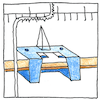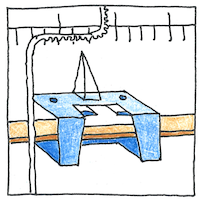William Thomson, Lord Kelvin
electromagnetism

|
Ampere balance
To measure the ampere, slide a weight on a scale to balance the current to be measured coiled against the weight.
Ampere calculation
The strength of the current when the weight is balanced is proportional to the product of the square root of the weight and its displacement from its zero position.
Balance
Nothing is that delicately balanced that the result comes from a simple equation. The scale must be level; we must know precisely the dimension and winding of the coil; and how do we measure the mechanical rigidity of linkages and pivots? In balancing a current against a weight, either current or weight might be off. We should apply Bayes’ theorem and balance the significance of what we know against the weight of what we don’t know.



The Kibble balance is seen as a more accurate version of the Ampere balance even though Kibble’s purpose was to measure a weight and Kelvin’s purpose was to measure a current.
See also in The book of science:
Readings in wikipedia:
Other readings: